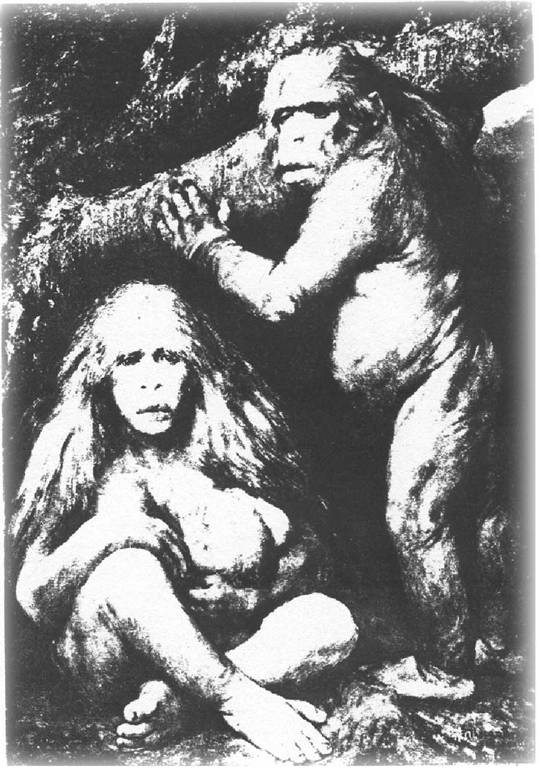
I open this post with one of Haeckel’s Artist’s Conceptions as to what Homo erectus was originally thought to have looked like. It will be important to remember this as we move on.
Also, I want to mention in passing, before we begin discussing “Erect Man” in earnest, some other players in this Evolutionary game of human ascension, notably Homo antecessor and Homo heidelbergensis (the recently found Homo “SP” is a human by most accounts). Here below is the cream of the crop concerning the fossils of antecessor:
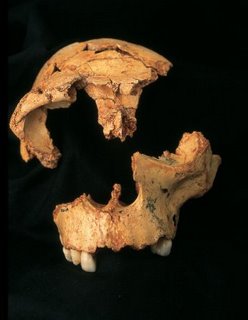
Homo heidelbergensis and Homo antecessor
“Forerunner Man” Homo antecessor refers to a series of fossils discovered near Atapuerca, Spain, in 1994 and 1995. Over 80 fragments have been found which supposedly came from 6 individuals. In the digs at Gran Dolina were also found some stone tools and animal bones. Here below is another photo of the finds:
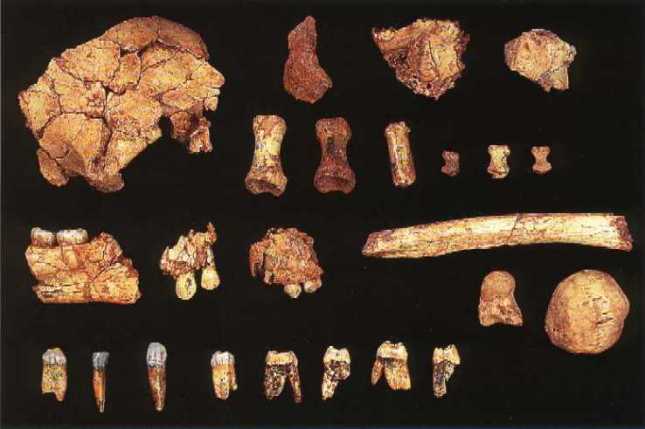
The evidence is not very much to go on. The dates given for Forerunner Man are in the vicinity of about 800,000 years ago. I want to just mention this very controversial species designation here for the sake of completeness. This source summarizes the problems involved with classifying antecessor, and for that matter, we should add, the same applies to heidelbergensis:
The species Homo antecessor is another very controversial species designation. The species was designated by J.L. Arsuaga et al. to the remains of several individuals found at the Gran Dolina site, Spain. The discovery was significant because the remains have been securely dated at over 780,000 years. This makes the material the earliest known European specimens. The find breathed new life into the argument for the validity of H. heidelbergensis, as well as creating a whole new species, H. antecessor. The most complete specimen is Hominid 3, which is also the type specimen for antecessor. This is unusual because Hominid 3 is a 10-year old, and therefore has not fully developed its skeletal characteristics. The specimen was chosen because it highlighted all the features that the researchers were attempting to describe as typic of the species. However, these features are all variable [even within the small sample from Gran Dolina itself!], and none are autapomorphic. Few researchers accept the antecessor taxon, instead considering the material heidelbergensis. H. antecessor may become a chronospecies (as many argue heidelbergensis is itself), but it has a very weak claim as a direct human ancestor or as a distinct taxon from heidelbergensis or erectus. [ibid. my emphases and brackets]
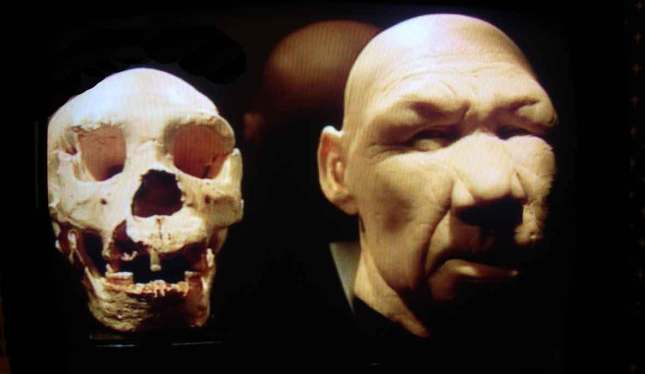
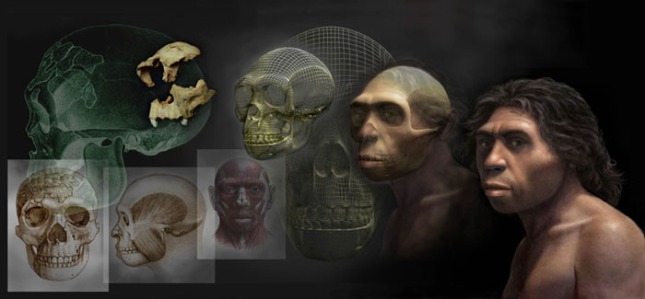
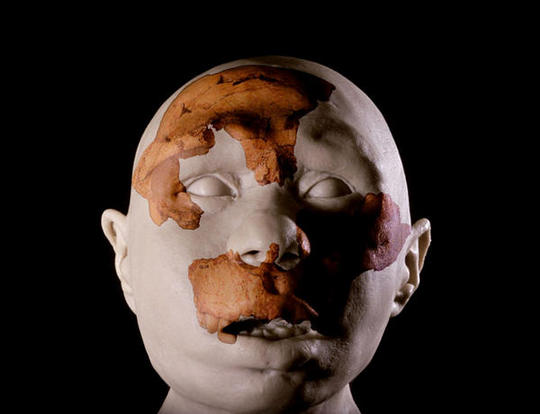
Very human in appearance seems Homo antecessor, at least from the reconstructions. In many ways certain of its fossils are more human-like than those of erectus, so it is not surprising that these two alleged human ancestors are said to have been contemporaries. Shortening Man’s initial appearance on Earth to 750 or 800 thousand years gives us a more reasonable amount of time to deal with, although we should neither begin to trust the dating methods that give us these numbers, nor accept these reconstructions of the slight material as accurate quite yet.
Homo heidelbergensis, as we said, is another somewhat controversial designation. This “species” was first discovered in Germany in 1907 in Mauer. Later finds have been discovered in Greece, Ethiopia, France, England, and Zambia. With the exception of a cranium found in Ethiopia, and actually even footprints in Italy, none of these have been dated any older than 300,000 years ago.
Footprints but no skulls in Italy? Maybe there was an “Ape Escape” and the African crossed into Europe for vacation? Think about the possibilities, namely how difficult it would be, or of even how one could possibly come to establish the age of such marks on the ground.
Let’s do a little detail. The cranium found by villagers in Petralona, Greece is impressive, especially reconstructed and polished, and also apparently human:
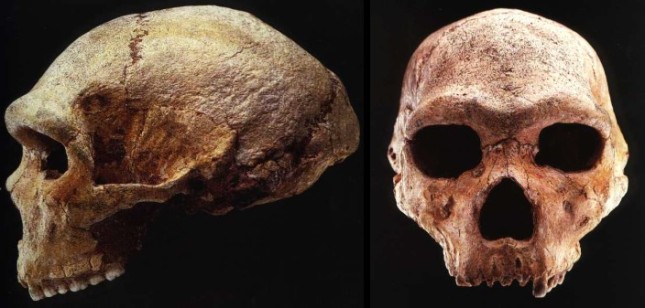
I doubt the age is as old as is claimed for several reasons, notably in that the teeth appear well-preserved and modernly human in size and structure. For comparison, let’s have a view of the oldest-dated specimen of erectus. This is Bodo, found in Ethiopia in 1976:
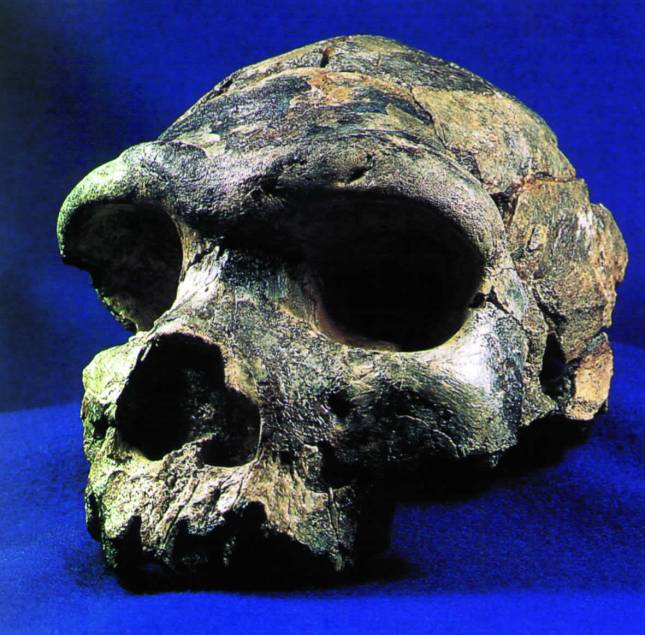
This skull is another assemblage of fragments, and at first glance holds more features in common with the australopithecines than erectus, let alone modern humans. It was also found with baboon and other ape specimens, further suggesting that it could be an ape of some kind. In the photo composite below is the more human-like Kabwe skull next to Bodo:
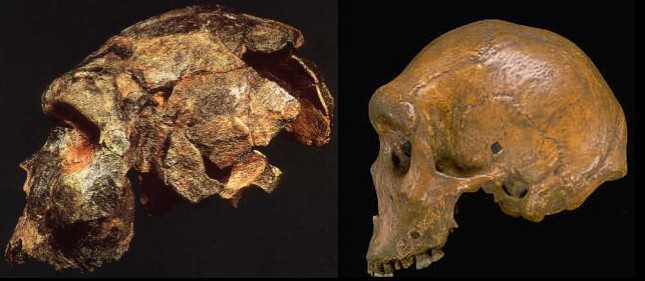
The two “intermediate” species Homo heidelbergensis and Homo antecessor are by the known evidence probably composite species. There is too much variation from one individual to the next to form a distinct type, and like some of our earlier samples, fossils seem to be lumped together arbitrarily. Were we to guess, we could hypothesize that all the members of this creature, or rather their parts, properly belong elsewhere, either as human, or as ape. No good proof exists that they form a distinct species. The samples are too few, the similarities, not enough.
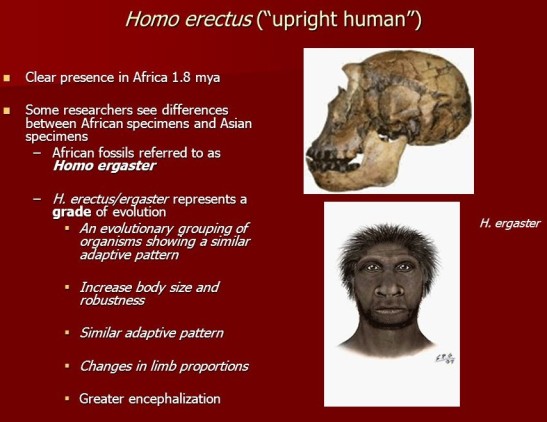
Homo erectus
Homo erectus, as the term is used, describes fossils of a wide-ranging structure, and as it appears can indicate a creature that may be either human or ape depending on which particular fragments and/or features you are looking at. Conversely, the cavemen we have discovered and have named Neanderthal Man (Homo neanderthalis), and the French cave painters known as Cro-Magnon, we will see later on, are completely human remains.
Erect Man, or Upright Man, was initially discovered by Eugene Dubois, a diehard Evolutionist who set out on a pre-planned, determined path to find the missing link. His finds in Java, the discovery of the famed “Java Man”, consisted of a partial skull cap and an apparently human femur. Later in the same vicinity other scraps and skulls caps were found. Since that time, one of these famous skull caps has apparently disappeared, a too common and hardly comprehensible fate for such monumental discoveries. That this lost cap has been reclassified nevertheless makes it all the more mind-boggling. As for the femur, whether actually belonging to the skull cap or not, it is by all evidence indistinguishable from that of any modern human being.
These Erect Man creatures supposedly existed around the same general time as did antecessor and heidelbergensis, occupying a vast range of possible existence. Depending who you ask, erectus could have flourished from as far back as over 1 million years ago, to as recent as 300,000 years ago, and the vast era in between. Recent claims in fact have claimed that Java Man was still alive 30,000 years ago, and was even “contemporary with modern humans”.
We have extant remains from at least 20 individuals. Some of these bones are also assigned across classifications, and so quite a few remains labeled as Erect Man are also cited as being evidence for homo ergaster (KNMER-3733, e.g.), and Homo antecessor as well. Some samples possibly unique to erectus have been found in South Africa, Algeria, and as we have said, Java.
Not to be outdone, the Leakeys have found themselves a specimen of this type in Tanzania. Here I present their evidence “Chellean Man” for your perusal. I tell you, that Olduvai Gorge has been worth more money than any diamond mine, especially to the Leakeys. Anyway, as a bonus, following that photograph I will present you the rest of the fossils from outside of China, all of them except the insignificant fragments, and supposedly indicative of Erect Man. First the Leakey Chellean Man “discovery”:
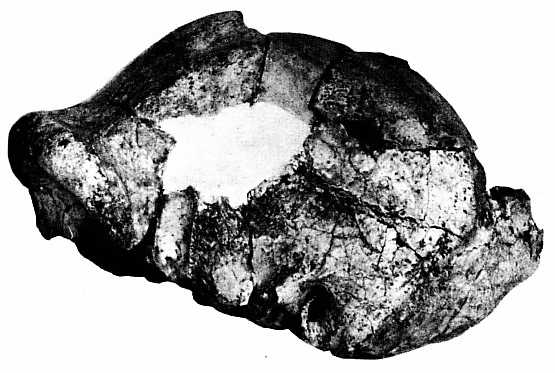
That speaks for itself, doesn’t it? Immediately below is the ever-important type specimen for Java Man (a replica):
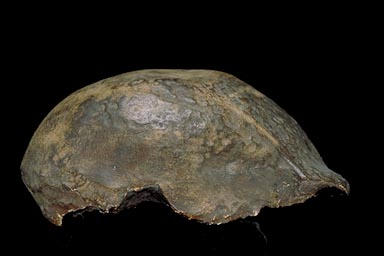
and here some more “fossils”:
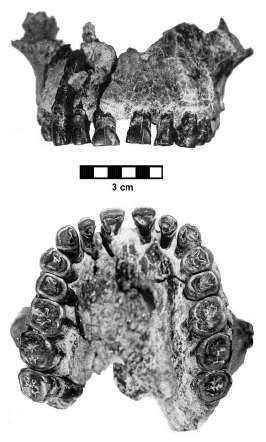

White and grey, above, is man-made. Notice also fissures/cracks and misaligned seams in the rest of the reconstructed cranium.
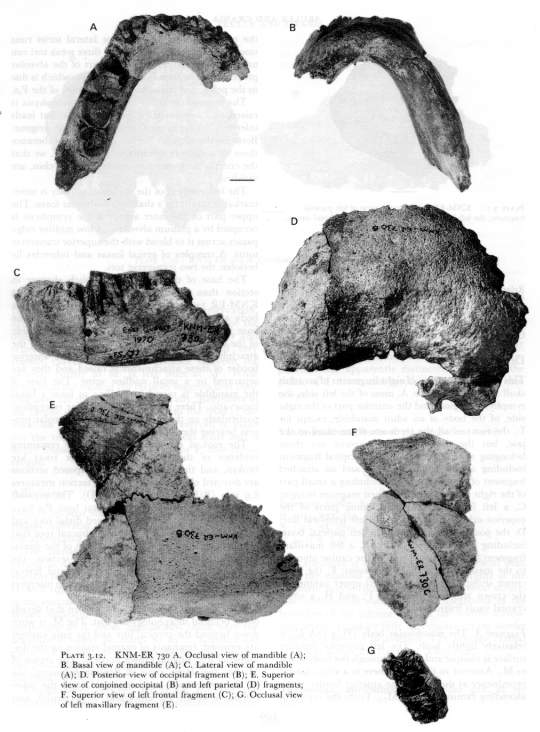
The proof for Homo erectus from outside of Asia is speculative at best. Considering the problems with the classification of these remains, and so the lack of scientific consensus about them, and given the evidence before us that we have to go on, it continues to appear as if Evolution has tried to build a skyscraper based on not even just one single solid brick, but rather, a bunch of brick pieces and assorted rubble. It’s not just the foundation’s instability that is disconcerting, it is the lack of honesty and self-criticism – and this wasting of scientific energy while we still have no genuine alternative to gasoline, still have uncured diseases, and still abide with our feeble batteries – that is particularly unsavory.
Do I digress? No matter, here below I present the most famous Artist Conception, what we are usually shown when given an example of the non-Chinese variant of Erect Man. I should add ahead of time that this “skull” also no longer exists, having disappeared during World War II. This picture is a pretty reconstruction:
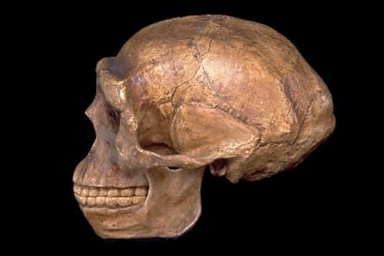
Found in China, one particularly famous subspecies of Homo erectus is known as Peking Man. Around 14 partial craniums of creatures of this type were unearthed, along with several jaws and numerous teeth, from the area around Peking, or Beijing, during the late 1920s through the late 1930s. On what is his fame based? Well, here is a collage of the most important fossil evidence of Peking Man, some of which have also disappeared:
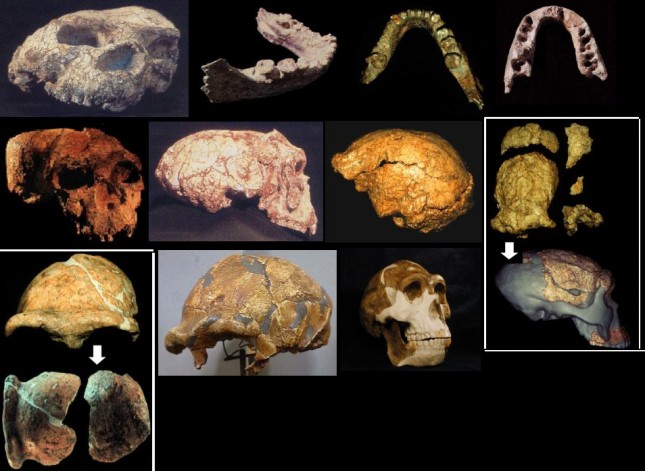
In general, Creationists and Evolutionists alike debate amongst themselves as to the merits of Erect Man, as they do about several other links in this imaginary human ancestor chain. Some Creationists, for example, consider this Homo erectus material as evidence of only apes while other Creationists consider it proof of human beings; some Evolutionists consider them transitional, others as ancient apes; still others on both sides say they are the first humans.
My opinion here, which is being informed by nothing more than the objective evidence available, must be that Homo erectus is too fragmented to tell us much of anything. The mitigating factors such as coexistent remains of juvenile chimps, adult monkeys, adolescent apes, other crushed skulls, eroded skulls, animal bones, and the like, plus the paltry number of extant specimens, all deter us from objectively accepting this as a creature with both human and ape traits. We cannot see it as a hybrid of any kind, what little there is to see. It does not help matters that in many cases even the best scientists and experts in the field can barely make out what these fossils represent.
We should, however, make note of the appearance of stone tools said to be the product of Homo erectus. The complexity and craftsmanship of some of the discovered spearheads and knives lend more credence to the humanity of erectus than any of the bones and other skulls. The problem is that we do not know for sure whether these tools belonged to erectus at all. They could have been from much later true humans.
I wish to explain another reason for this rejection, which is my discontent with criteria like the brow-ridge line or cranium shape as indicative of primitive structure, and this on two grounds. On the first, I believe that the erosion of a skull over time is particularly vulnerable at the forehead, that is, that region just above the brow line. Because of the way the skull would naturally sit, this forehead-region would be most exposed to the elements and wear and tear. In contrast, the brow is itself much thicker, and less prone to erode over time. This might account for several human skulls appearing not quite so human. In the second case, I reject these skull-related claims because various degrees of this brow ridge, variations in cranium shape and size, and degree and strength of jaw protrusion, among other “distinguishing characteristics” continue to exist, and are observable among the population today. Look at the next person you see, and wonder if his or her skull would look like yours.
As an example of skull variance here below are some much more contemporary human skulls, first from Bhutan (top), then from the massacres at and around Cambodia, and finally, (bottom) from Thailand:





What I am trying to call attention to here is the variation of skull structure for more-or-less contemporary individuals from the same general region. Notice the differences in degree of brow protrusion, not merely from one photo to the next, but especially those in the same photos. You will see in every case differences in overall size, cranial shape, dentition, forehead slope, eye socket size and position, mandible size, breadth of the nasal bone, and of course supra-orbital differences, like differences of brow ridge line. Skulls from more remote regions, say a comparison of German and Eskimo skulls, today, would show even greater differences in bone structure.
Keep this in mind as we go forward, because if we reject the evidence for this Erect Man, we will nevertheless, as we will see, have to make a different evaluation when we get to the Neanderthals, our next subject. Neanderthals, by all evidence (which is much better than for erectus), and despite what scientific consensus still claims, are full-blown humans.
Let us look at the by-now usual Artist’s Conceptions as to what this Erect Man was supposed to have looked like. We here at Truthopia support the Arts – even if we don’t always agree with their message:

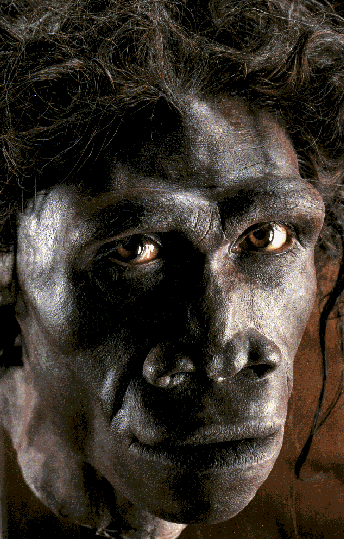
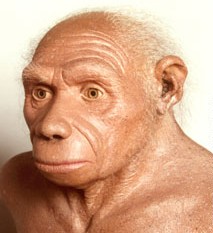
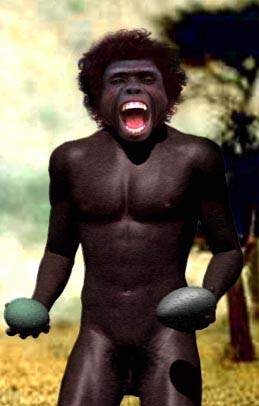
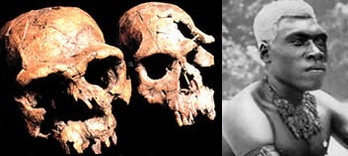
This two-part photo directly above compares a Malaysian native, a type with strong jaw and brow still existent today, with erectus fossils.
And what would our excavators and archaeologists and Leakey theorists believe they have found, had others not already discovered paintings and writings about these skulls below, from Peru and Egypt:
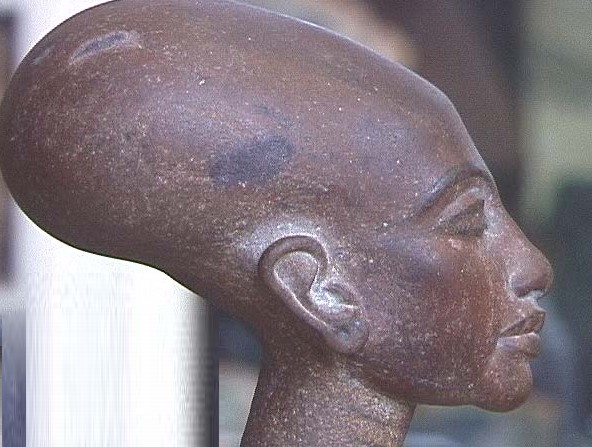
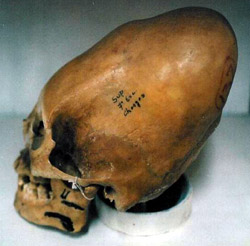
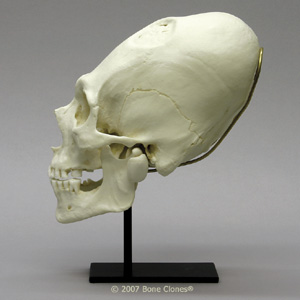
Can we discount, even, human-imposed irregularities?
Next time, the Neanderthals. Maybe then we can finally start feeling some kinship, and a bit more in tune with the world.




isidore560
February 1, 2015 at 6:48 pm
The cranial deformation in the statues and images is clearly the product of human effort.
The native with the Erectus- like brow ridges was nrown with that feature. In fact, sooner or later we are going to have to contend with the reality that an erectus- hybrid walks among us.
Bantu Africans are the direct result of cross-pollination between early Homo sapiens ( Khoisan- like peoples) and an “unknown hominid species.” Gee, I wonder what species that is, and why for some reason there aren’t any studies attempting to determine that? We have had no problem highlighting Neanderthal blood in Eurasians ( a sign they race generalizations are very much ” real” in s practical sense). Why is it that we can’t seen to figure out the non- human species that played a role in the evolution of west african Bantus?
isidore560
February 1, 2015 at 6:49 pm
‘ “Born.”
It’s difficukt (sic. Lol) to type tonight.